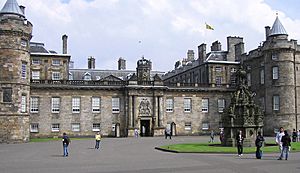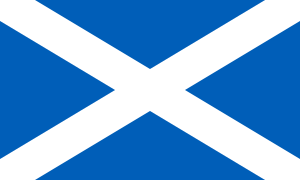Royal Banner of Scotland facts for kids
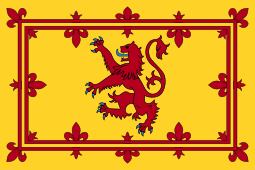 |
|
| Name |
|
|---|---|
| Proportion |
|
| Adopted | 13th century |
| Design | Red (Gules) lion rampant with blue (Azure) claws and tongue, within a red double border having a motif of alternating heraldic lilies, on a yellow (Or) field. |
The Royal Banner of the Royal Arms of Scotland is a very old and important flag. It's often called the Lion Rampant of Scotland or the Royal Banner of Scotland. Historically, it was the main flag of the Kingdom of Scotland's kings.
This banner is different from Scotland's national flag, the Saltire. The Lion Rampant is a special flag. Only a few important people who represent the King or Queen in Scotland are allowed to use it officially. You can also see it flying at royal homes in Scotland, but only when the King or Queen isn't there.
The first time the Lion Rampant was used as a royal symbol in Scotland was around 1222 by King Alexander II. Later, during the time of King Alexander III (1249–1286), the flag got its fancy double border with lily symbols. This lion symbol was on the shield of Scotland's royal coat of arms. Kings of Scots used it until 1603. That's when James VI became King of England and Ireland too, uniting the crowns.
Since 1603, the Scottish Lion Rampant has been part of the royal flags and coats of arms for all British monarchs. It helps show that Scotland is part of the United Kingdom. Even though its official use is limited, the Royal Banner is still one of Scotland's most famous symbols.
Contents
What the Royal Banner Looks Like
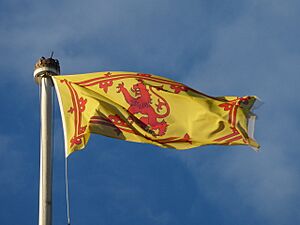
The Royal Banner of Scotland has a bright yellow background. On it, you'll see a red lion standing on its back legs, as if it's ready to pounce. This is called a "lion rampant." The lion has blue claws and a blue tongue. Around the lion, there's a special double red border. This border is decorated with pairs of lily symbols facing each other.
In the language of flags and symbols (called heraldry), this design is described as: Or, a lion rampant Gules armed and langued Azure within a double tressure flory counter-flory of the second. This means:
- Or (gold) is the yellow background.
- A lion rampant is the upright lion.
- Gules (red) is the color of the lion.
- Armed and langued Azure means the lion's claws and tongue are blue.
- The double tressure flory counter-flory of the second describes the red double border with the opposing lily symbols.
When used as a house flag, its size ratio is usually 5:4. However, flag makers sometimes use other sizes, like 1:2 or 2:3.
History of the Lion Rampant
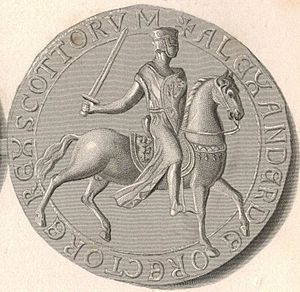
The Lion Rampant has been a symbol for Scottish rulers since the time of Malcolm III (1058–1093). King David I also used it. The Great Seal of Alexander II (1214–1249) clearly showed the lion.
Before the lion, an early Scottish royal flag featured a dragon. This was used at the Battle of the Standard in 1138 by David I. It's also believed that Robert the Bruce, King Robert I, wore a yellow tunic with the red Lion Rampant at the Battle of Bannockburn in 1314.
After 1603, when England, Ireland, and Scotland joined under one king, the Royal Banner of Scotland became part of the larger royal flags. These flags are divided into sections, with each section representing a kingdom. Since 1603, the Scottish Lion Rampant appears in the first and fourth sections of the royal flag used in Scotland. In other places, it appears in the second section.
Who Can Use the Royal Banner
At Royal Homes
The Royal Banner of Scotland is flown at Scottish royal homes like the Palace of Holyroodhouse in Edinburgh and Balmoral Castle in Aberdeenshire. But it's only flown when the King is not there. When the King is present, the Royal Standard of the United Kingdom is flown instead.
By Royal Representatives
In Scotland, some important officials who represent the King or Queen are allowed to use the Royal Banner. These include:
- The First Minister of Scotland
- Local representatives called Lord Lieutenants
- The Lord High Commissioner to the General Assembly of the Church of Scotland
- The Lord Lyon King of Arms (who oversees heraldry in Scotland)
- Other special representatives appointed by the King.
By the Heir to the Throne
The person next in line to become King or Queen, known as the heir apparent, also has a version of the Royal Banner. This is the main banner with a small blue three-pointed shape added to it. This special flag is used by the Duke of Rothesay, which is the title for the heir to the throne in Scotland.
Rules for Using the Banner
Because it's the King's personal flag, the Royal Banner of Scotland has strict rules about its use. These rules come from old laws passed by the Parliament of Scotland. Using the banner without permission is against the law.
For example, in 1978, a man was fined for using the banner on bedspreads without permission. Even famous groups like Rangers F.C. and the Scottish National Party have been warned for using it improperly. Despite these rules, you can still see the flag on many souvenirs and items sold to tourists in Scotland.
In 1934, George V allowed people to use small, hand-held Royal Banners for his Silver Jubilee celebrations. This was a way to show loyalty to the King. However, these flags were not allowed to be flown from flagpoles or public buildings. Today, people still use hand-held flags at events like the opening of the Scottish Parliament and at sporting events.
Other Royal Flags with the Lion Rampant
The Royal Banner of Scotland is not only used by itself. It's also a key part of other royal flags:
- It forms the basis for the flag of the Duke of Rothesay.
- Since 1603, it has been a part of the Royal Standard of the United Kingdom. This flag has different versions for use in Scotland and outside Scotland.
- It also appears in the Queen's personal Canadian standard. This flag includes symbols for England, Scotland, Ireland, and France.
Gallery
-
Royal flags displayed in St Giles' Cathedral, Edinburgh.
-
The Royal Standard of the United Kingdom flying over Palace of Holyrood House, Edinburgh.
-
The Royal Standard of the United Kingdom flying over Buckingham Palace, London.
-
Queen Elizabeth II's personal Canadian flag flying over the Peace Tower, Ottawa.
-
The Royal Banner of Scotland flying over Balmoral Castle, Aberdeenshire.
Scotland's National Flag
The Flag of Scotland, also known as the Saint Andrew's Cross or The Saltire, is Scotland's official national flag. It has a white X-shaped cross on a blue background. This flag is flown from Scottish Government buildings every day from morning until sunset, except on certain national holidays in the United Kingdom.
See also
 In Spanish: Estandarte Real de Escocia para niños
In Spanish: Estandarte Real de Escocia para niños
- Royal coat of arms of Scotland
- Royal Standard of the United Kingdom
- Duke of Rothesay
- List of Scottish flags
- Scottish heraldry


